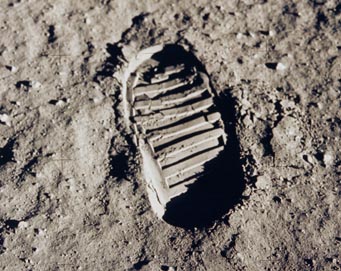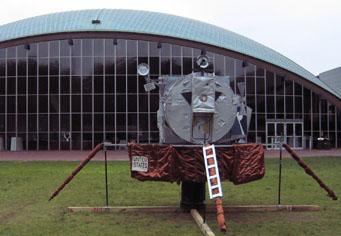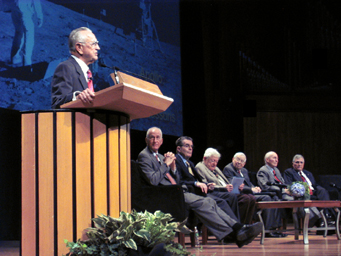I'm not big on space-exploration nostalgia, though I'm surprised that the world's space buffs didn't make a bigger deal of the 50th anniversary of Sputnik 1's launch last October. (For Sky Publishing's take on that watershed event, click here.)

In an accomplishment that is still considered by many to have been the pinnacle of human achievement in space so far, Neil Armstrong and Buzz Aldrin left the first human footprints in the fine-grained lunar soil on July 20, 1969, fulfilling President Kennedy’s 1961 pledge.
NASA
In any case, about a month from now NASA, the Smithsonian Institution, and other organizations will make much ado concerning the 40th anniversary of the Apollo 11 lunar landing in 1969.
There's good reason to pull out all the stops now, rather than to wait another 10 years. Apollo 11's crew of Neil Armstrong, Buzz Aldrin, and Michael Collins are all in their late 70s. The project's key managers are even older, if not already deceased. When it comes to Apollo reminiscences, time is of the essence.
So yesterday I found myself in the futuristic Kresge Auditorium on the MIT campus to relive NASA's finest and most audacious accomplishment. The three-day Giant Leaps symposium had managed to draw a stellar list of attendees — including publicity-shy Armstrong, not-so-shy Aldrin, and mission director Chris Kraft. As co-organizer Maria Zuber explained, "We decided to have it this early to make sure we could get the people here we wanted."
Fittingly, Frank Sinatra's "Fly Me To the Moon" drifted down from the speakers overhead as the crowd settled in.

Scene of an alien landing? No — just a student-built mockup of Apollo's lunar module in from of the futuristic Kresge Auditorium on the MIT campus.
J. Kelly Beatty
MIT didn't have a large role in the Apollo effort, but it did have a crucial one: Charles Stark "Doc" Draper and his staff at the school's Instrumentation Laboratory built the 1-cubic-foot, 70-pound Guidance and Navigation Computer that reliably guided those capsules to and from the Moon.
(Two footnotes of note: (1) MIT received the first contract issued by NASA for the Apollo program; and (2) the GNC's precursor was the computer that Draper's team built for a self-navigating spacecraft designed to make a round trip to Mars in the early 1960s. NASA managers weren't interested in Draper's Mars probe, but they sure were wowed by its computer.)
Even with 40 yeas of hindsight, it's amazing that Apollo worked at all &mdash let alone succeeded so spectacularly. "When President Kennedy announced his decision to go to the Moon in May 1961," Kraft recalled, "I thought he'd lost his mind." The effort to fulfill Kennedy's commitment was full of gutsy calls. For example, Kraft reminded the audience that, during its final qualification flight in 1968 (Apollo 6), the mammoth Saturn V launch rocket experienced serious problems with all three of its stages — yet the very next launch carried Apollo 8's crew to the Moon and back.
More than one speaker asked aloud whether the Apollo program could be undertaken today. Harrison "Jack" Schmitt said that he and fellow Moonwalker Armstrong had often reflected on the program's keys to success, then he ticked off the list they'd come up with:
• a sufficient base of technology
• a reservoir of young engineers and skilled workers
• a pervasive environment of national unease
• a catalytic event (Yuri Gagarin's historic flight)
• an articulate and persuasive president
• adequate funding
• a culture of organizational liberty with tough, competent managers

Former Apollo mission director Chris Kraft addresses MIT's "Giant Leaps" symposium on June 10, 2009. Looking on, left to right, are: Jeffrey Hoffman (former shuttle astronaut); Theodore Sorensen (special counsel to President Kennedy); Richard Battin (Apollo guidance lead); Aaron Cohen (Apollo CSM manager); Joseph Gain (Apollo lunar-module director); and Harrison "Jack" Schmitt (Apollo 17 astronaut). Click on the image for a larger view.
J. Kelly Beatty
A pair of panels at Giant Leaps tried their best to frame future advances in aeronautics and space exploration. And NASA is planning a return to the Moon, with its chronically underfunded Constellation program.
But I wouldn't get too excited about Constellation's prospects just yet. On June 1st, NASA's acting administrator tasked a blue-ribbon committee to review the agency's plans for human spaceflight. Headed by Norman Augustine, who chaired a similar task force in 1990, the panel's recommendations are due within 120 days. So stay tuned!
 0
0
Comments
You must be logged in to post a comment.